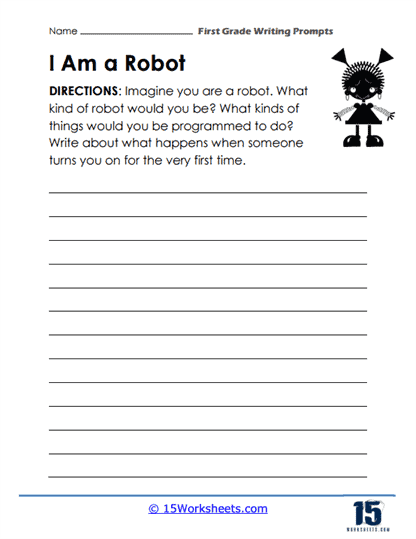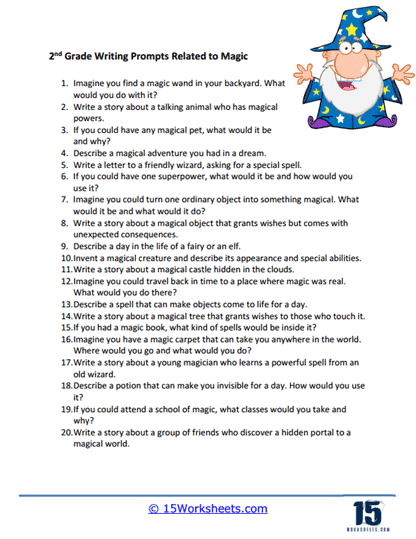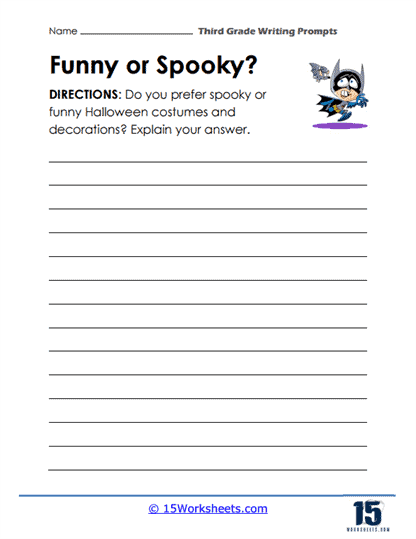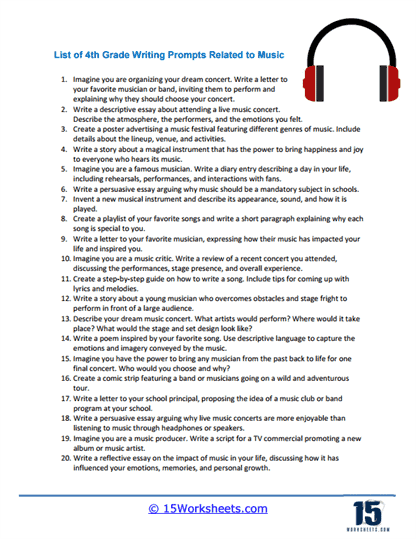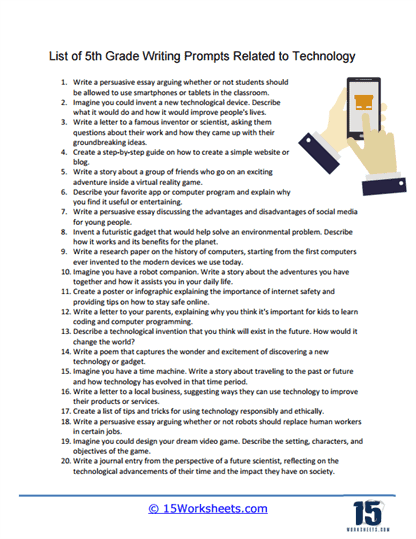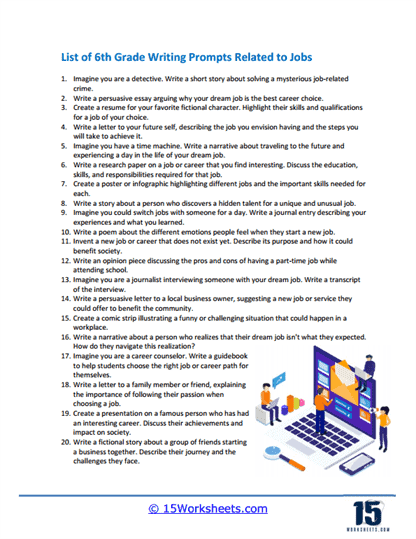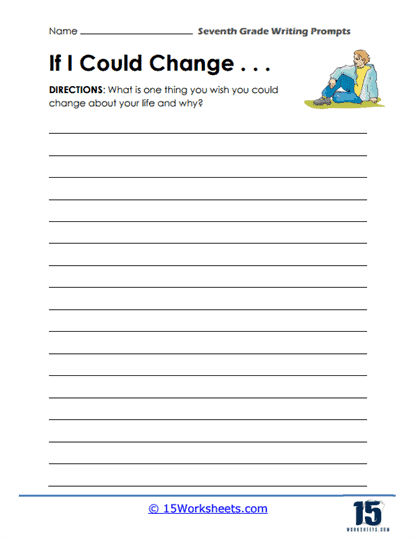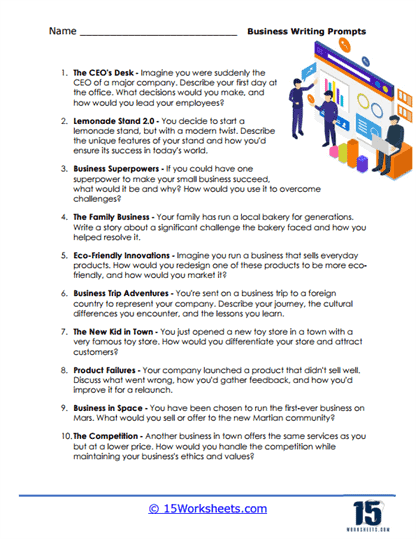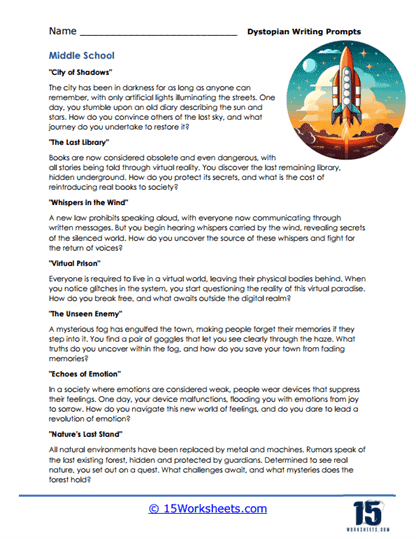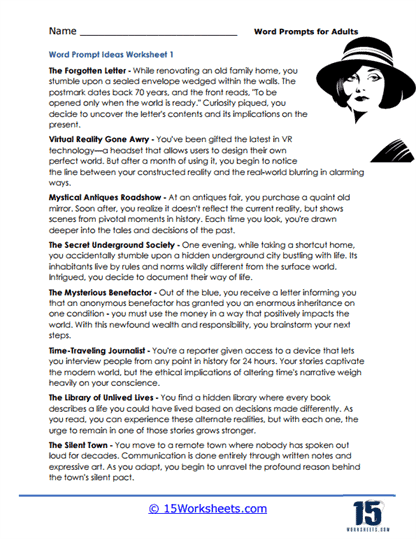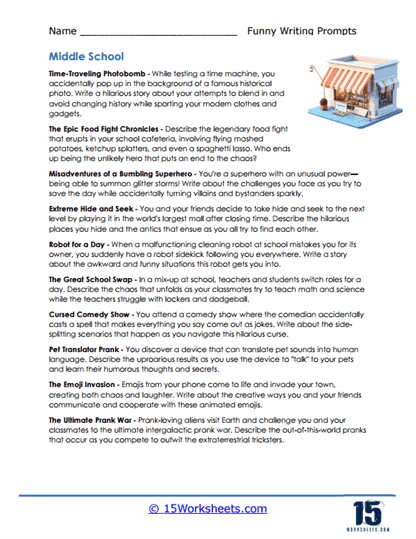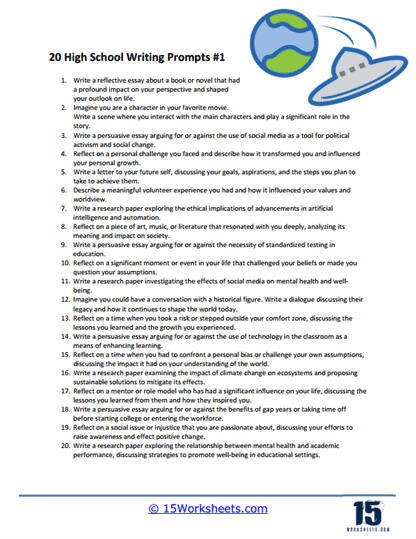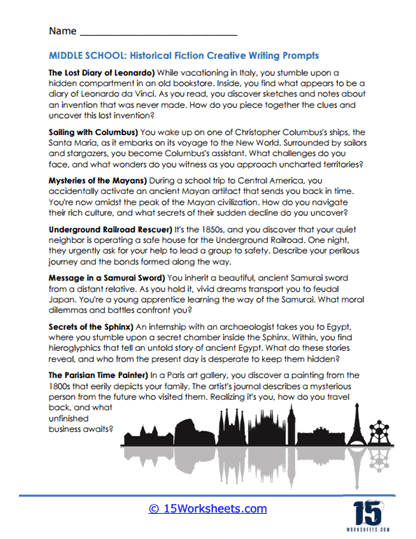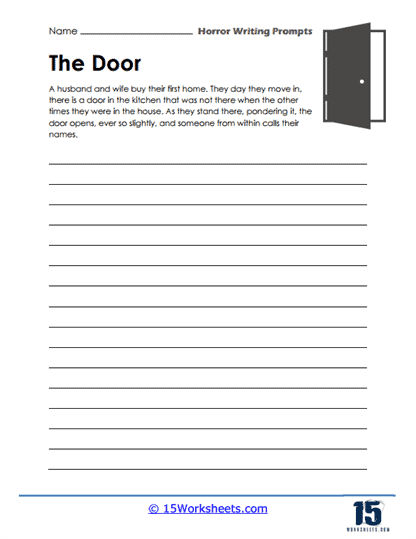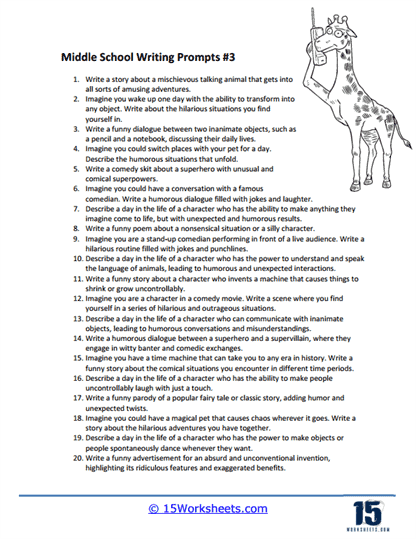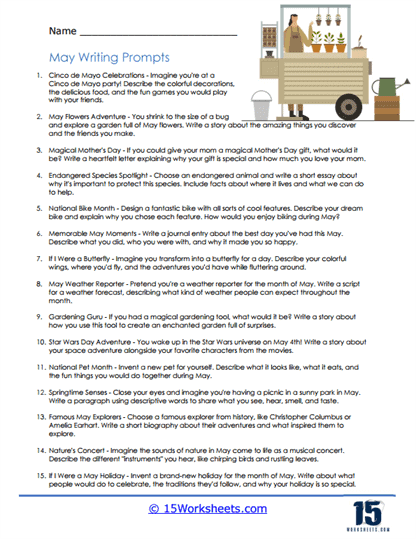Writing Prompts Worksheets
About These 15 Worksheets
Writing prompt worksheets are a powerful tool that ignites the imagination and fosters creativity in students. These worksheets serve as a launchpad for developing writing skills by providing a clear starting point, whether through a short scenario, thought-provoking question, or abstract concept designed to spark ideas. By offering structure to those who might struggle to come up with ideas on their own, these prompts help break through the daunting blank page and inspire rich, thoughtful responses. A well-crafted prompt could range from an adventurous scenario like “Imagine you wake up and discover you’re invisible for a day. What do you do?” to more philosophical questions such as “What does freedom mean to you?” Through such exercises, students not only get a foothold to start writing, but they also cultivate essential skills like critical thinking, creativity, and articulation.
The primary goal of these worksheets is to help writers, especially students, combat writer’s block and transform vague ideas into coherent thoughts. As students engage with prompts regularly, they become more adept at thinking critically and translating their inner reflections into structured written responses. These exercises provide a low-pressure opportunity to practice and develop writing habits that are crucial for academic success and personal expression.
Writing prompt worksheets are not merely tools for generating writing content; they are stepping stones toward honing writing skills. Consistent practice through prompts helps students become more familiar and comfortable with the writing process. Like any skill, writing improves with regular use, and writing prompts ensure that students are exposed to varied writing styles, genres, and tones. Whether the task at hand is descriptive language, constructing a persuasive argument, or telling a fictional story, the prompts guide students into the practice of structured writing. This variety in writing styles broadens a student’s abilities, allowing them to explore different methods of expression. Over time, this exposure builds stronger vocabulary, refines grammar, and enhances the overall clarity of their work.
By responding to a diverse set of writing prompts, students experience growth in ways beyond the purely technical aspects of writing. Engaging with prompts also enhances communication and expressive abilities. Writing exercises often require the student to reflect on personal experiences, share opinions, or convey feelings. In doing so, they learn to communicate complex ideas, emotions, and perspectives with greater clarity and depth. For instance, when asked to reflect on a personal challenge or express their values, students are encouraged to dive deep into their thoughts and articulate emotions that they might otherwise struggle to express. These exercises teach students to shape their thoughts with precision, which in turn improves not only their writing but also their verbal communication skills. The benefits of writing prompts go far beyond the classroom—they foster empathy, critical reflection, and a greater understanding of oneself and others.
The creative potential of writing prompts cannot be overlooked. Many prompts invite students to imagine unique scenarios, explore fantastical worlds, or solve complex problems through storytelling. This aspect of writing taps into the student’s creativity, encouraging them to think outside the box and embrace innovative approaches to both writing and thinking. For example, prompts like “Write a story about a child who discovers a magic stone” stimulate the imagination and challenge students to create a world around the concept. This kind of imaginative exercise develops creative thinking skills, which are valuable not only in artistic pursuits but also in real-world problem-solving situations. When students are encouraged to think creatively, they become more adaptable and innovative in their approach to all forms of work and life challenges.
How to Approach Writing Prompts
Everyone has their own process, but answering a writing prompt effectively requires understanding the prompt, organizing your thoughts, and using good writing practices. Here’s a step-by-step guide:
Approaching a writing prompt thoughtfully is key to fully realizing its potential benefits. The first step for students when faced with a prompt is to carefully read and analyze it. Understanding the task is crucial, as different prompts may require different approaches. Some prompts might call for a narrative response, where students craft a story, while others may seek an opinion or analysis on a particular theme. Once the nature of the prompt is clear, the next step is brainstorming. This process allows students to explore potential directions for their writing, whether through jotting down ideas, sketching out characters, or listing possible themes. Brainstorming opens up a wealth of possibilities, ensuring that students don’t feel restricted by a lack of immediate ideas.
Clearly Understand – The first step is to read the prompt carefully and understand what it’s asking. Look for keywords that will guide your response, like “explain,” “describe,” “argue,” or “compare.” If it’s a complex prompt, break it down into smaller parts.
Brainstorm – Once you understand the prompt, brainstorm ideas related to it. This is the time to let your thoughts flow freely without worrying about the structure or grammar.
Formulate a Thesis Statement – The thesis statement is your main argument or point in response to the prompt. It should be clear, concise, and directly answer the prompt.
Create an Outline – An outline will help you organize your thoughts. It typically includes an introduction, body paragraphs, and a conclusion. Each body paragraph should have a main idea that supports your thesis statement.
Begin the Writing Process – Begin by writing the introduction. This should introduce the topic and end with your thesis statement. Next, write the body paragraphs, making sure each paragraph supports your thesis. Finally, write the conclusion that summarizes your main points and reiterates your thesis.
Revise and Edit – Once your draft is complete, revise it for clarity, coherence, and logic. Check the flow of ideas and whether each paragraph effectively supports the thesis. After revising, proofread to correct grammar, punctuation, and spelling errors.
Types of Writing Prompts
1. Narrative Prompts
Narrative prompts encourage students to tell a story, either based on real-life experiences or entirely fictional scenarios. These prompts are designed to help students develop their storytelling abilities, focusing on plot structure, character development, and conflict resolution. They might begin with a situation or character and ask the student to build a complete story around it.
For example:
“Write a story about a child who discovers a magic stone that can grant wishes.”
“Imagine you are an astronaut on your first mission to the moon. What happens during your adventure?”
Purpose – Narrative prompts help students practice writing with a clear beginning, middle, and end. They enhance creativity, improve descriptive abilities, and encourage students to explore different literary elements such as dialogue, character arcs, and suspense. These prompts are particularly useful in helping students understand how to create tension, resolve conflict, and develop a narrative voice.
2. Expository Prompts
Expository prompts ask students to explain a concept, process, or idea in a clear and logical manner. These prompts focus on informative writing, where the goal is to present information, clarify how something works, or describe an event in a factual way without the need for opinion or creativity.
For example:
“Explain the process of how a plant grows from a seed.”
“Describe the importance of recycling and how it helps the environment.”
Purpose – Expository writing encourages students to focus on clarity, structure, and detail. It is an essential skill for academic writing, where presenting factual information and explaining ideas logically are crucial. These prompts teach students how to organize their thoughts, avoid unnecessary tangents, and provide sufficient evidence or details to support their explanations.
3. Persuasive Prompts
Persuasive prompts challenge students to write with the goal of convincing the reader to adopt a particular viewpoint or take a specific action. These prompts typically present a statement or issue and ask the student to develop an argument supporting one side of the debate. Persuasive writing involves crafting logical arguments, using evidence, and employing emotional appeal to sway the reader’s opinion.
For example:
“Convince your reader that school uniforms should be mandatory.”
“Write an essay persuading your audience that social media does more harm than good.”
Purpose – Persuasive prompts help students learn to form coherent arguments and defend their positions with evidence. They teach important rhetorical strategies like using logic (logos), appealing to emotions (pathos), and establishing credibility (ethos). Persuasive writing is a critical skill not only for academic assignments but also for real-world communication, such as debates, opinion pieces, or advocacy work.
4. Descriptive Prompts
Descriptive prompts encourage students to describe a person, place, object, or event in vivid detail. These prompts focus on using sensory language to create a rich, immersive experience for the reader. The aim is to make the reader feel as though they are experiencing the subject through the writer’s eyes, using strong adjectives, similes, metaphors, and other literary devices to paint a picture.
For example:
“Describe your dream vacation destination.”
“Write a detailed description of your favorite meal.”
Purpose – Descriptive writing enhances a student’s ability to observe and depict the world around them. It sharpens their use of sensory language—sight, sound, smell, taste, and touch—helping them craft more vivid and engaging prose. Descriptive prompts also encourage students to focus on small details and think about how word choices affect the reader’s perception.
5. Reflective Prompts
Reflective prompts ask students to think critically about their personal experiences, emotions, or beliefs. These prompts encourage introspection, requiring students to explore how past experiences have shaped them, what they’ve learned from a particular situation, or how they feel about certain issues. Reflective writing often takes the form of personal essays or journal entries.
For example:
“Write about a time when you overcame a personal challenge.”
“Reflect on a moment in your life that changed your perspective on the world.”
Purpose – Reflective writing prompts foster emotional intelligence and self-awareness. They encourage students to process and articulate their thoughts and feelings, helping them gain deeper insights into their own actions and decisions. Reflective writing also strengthens a student’s ability to connect personal experiences to broader themes, making it a valuable exercise for both personal growth and academic writing.
6. Analytical Prompts
Analytical prompts ask students to break down and evaluate information, such as a text, event, or issue. These prompts focus on analysis rather than storytelling or opinion. Students must examine different components of the subject, such as themes, characters, or arguments, and discuss how these parts work together to create a whole. Analytical prompts are common in literature and history classes but can be used in other subjects as well.
For example:
“Analyze the theme of friendship in the novel The Outsiders.”
“Evaluate the causes and consequences of the American Revolution.”
Purpose – Analytical writing helps students develop critical thinking and interpretation skills. These prompts require them to go beyond surface-level observations and delve into deeper meanings or causes. Analytical writing is foundational for academic essays, where students must assess evidence, draw connections, and form coherent interpretations.
7. Creative Prompts
Creative prompts are open-ended and designed to stimulate students’ imaginations. Unlike narrative prompts, which often provide a framework for a story, creative prompts give students complete freedom to invent characters, worlds, or situations. These prompts encourage out-of-the-box thinking and allow students to explore unique ideas without restrictions.
For example:
“Invent a world where gravity works differently. Describe how life functions there.”
“Create a character who can communicate with animals and describe their first adventure together.”
Purpose – Creative writing prompts are designed to boost creativity and innovation. They encourage students to take risks in their writing, explore new ideas, and break free from conventional thinking. Creative prompts are particularly useful for students interested in writing fiction, poetry, or speculative work, but they also help all students build confidence in generating and developing original ideas.
8. Opinion Prompts
Opinion prompts ask students to express their views on a given topic or issue, backed by reasons and examples. Unlike persuasive prompts, which aim to convince others, opinion prompts simply ask students to explain their stance on a subject.
For example:
“Do you think homework should be limited? Why or why not?”
“Which is better – online learning or in-person learning? Give reasons for your choice.”
Purpose – Opinion prompts help students practice articulating their beliefs clearly and logically. These prompts encourage them to think about why they hold certain views and how to support their opinions with rational arguments. They also help students learn how to communicate personal perspectives respectfully, which is a valuable skill in discussions and debates.
9. Comparative Prompts
Comparative prompts require students to examine two or more subjects and explain their similarities and differences. This type of prompt is often used to teach students how to analyze multiple perspectives or ideas and make informed conclusions.
For example:
“Compare and contrast the main characters in To Kill a Mockingbird and The Catcher in the Rye.”
“What are the differences between city life and country life?”
Purpose – Comparative writing teaches students how to organize and present complex ideas clearly. It sharpens their analytical abilities and helps them develop skills in making connections between different topics or perspectives. Comparative prompts also encourage logical thinking, as students must identify criteria for comparison and evaluate evidence.
How Do They Help Students?
Spark Creativity – By offering a starting point or an idea, writing prompts can stimulate a student’s imagination, leading them to create unique stories or arguments. This helps nurture creativity and out-of-the-box thinking.
Develop Writing Fluency – Regular use of writing prompts helps students get into the habit of writing often. The more they write, the better they get at expressing their thoughts, building a strong vocabulary, and improving sentence structure and grammar.
Enhance Critical Thinking – Some writing prompts ask students to form an argument, analyze a situation, or think deeply about a concept. This encourages critical thinking and analytical skills, which are vital for academic writing and beyond.
Improve Narrative Skills – Prompts that require narrative writing help students improve their ability to structure a story, develop characters, build a plot, and describe settings or events effectively.
Learn to Write under Constraints – Writing prompts often come with constraints, like word limits or specific themes. This helps students learn to write within certain boundaries, which can be a valuable skill, especially for timed exams or standardized tests.
Encourage Reflection – Some prompts may ask students to write about their personal experiences or thoughts. This introspective writing can improve self-awareness and personal growth.
Facilitate Practice across Different Genres – Worksheets can include a variety of prompts that require students to write in different styles and genres (like persuasive writing, descriptive writing, expository writing, etc.). This helps students gain experience and become comfortable writing in different contexts.
Boost Confidence – As students continue to write and improve, they generally become more confident in their abilities to express their thoughts in writing.
How You Can Use These With Students
Start each class with a writing exercise where students have to respond to a prompt. This can help students develop a regular writing habit and enhance their fluency in writing. Use prompts that stimulate creativity and imagination. Students can write short stories, poetry, or narrative essays based on these prompts, helping to hone their creative writing skills.
Use prompts that ask students to explain a process, describe an event, or explore a topic. These types of prompts will help students practice writing in a clear and organized manner, which is crucial for academic and professional writing. Choose prompts that require students to take a stand on an issue and provide arguments to support their viewpoint. This helps students develop their argumentative writing skills and fosters critical thinking.
Encourage students to maintain a daily or weekly journal where they respond to personal reflection prompts. This can improve self-expression, emotional awareness, and introspective thinking. Have students share their written responses with classmates for feedback. This encourages collaborative learning and helps students learn to give and receive constructive criticism.

